Monuments in Bhutan stand as timeless symbols of the country’s deep-rooted traditions and harmonious relationship with nature. Nestled in the heart of the Himalayas, the “Land of the Thunder Dragon” is a breathtaking kingdom bordered by India and China, renowned for its pristine mountain landscapes and vibrant Buddhist culture. The capital, Thimphu, located in west-central Bhutan along the Wang Chhu River, is surrounded by majestic peaks and lush valleys. Iconic sites like the famed Tiger’s Nest Monastery reflect the rich heritage and spiritual depth of Bhutan’s awe-inspiring monuments.
10 Must-See Monuments In Bhutan
These monuments in Bhutan blend scenic landscapes and deeply ingrained spirituality, offering memorable experiences to all types of travellers.
1. Kyichu Lhakhang
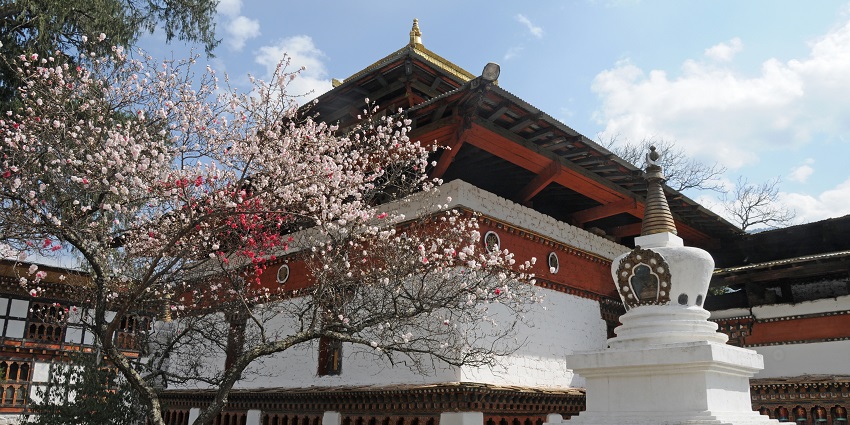
Photo: David Broad / Wikimedia Commons
Kyichu Lhakhang is a 7th-century monument in Bhutan. Its peaceful courtyard, surrounded by flowers and prayer wheels, is where one can turn the wheels to gain good karma, see ancient murals, and absorb the peaceful spiritual ambience. The serene and historical ambience attracts those who wish to engage themselves in Bhutanese culture to an even higher level.
Location: Paro, 5 km from town
Nearest Airport: Paro (6 km)
Suggested Read: Discover The Top Places To Visit In Bhutan
2. Punakha Dzong
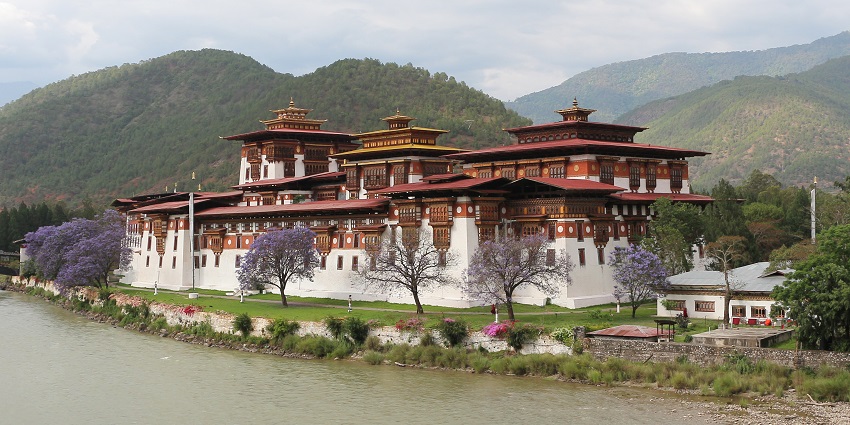
Photo: Bernard Gagnon / Wikimedia Commons
Punakha Dzong, the “Palace of Great Happiness,” is one of the loveliest monuments of Bhutan and is situated where two rivers converge. Its white-washed facade, beautiful wood carvings, and coloured murals make it a stunning vista. Visitors can stroll across picturesque courtyards, trek over the beautifully carved centuries-old wooden bridge, and enjoy the scenic view of the energetic Punakha Tshechu festival in spring.
Location: Punakha, central Bhutan
Entry Fee: BTN 300 / ₹300
Major Attractions: Dzong design, river views, festival spirit
3. Tashichho Dzong In Thimphu
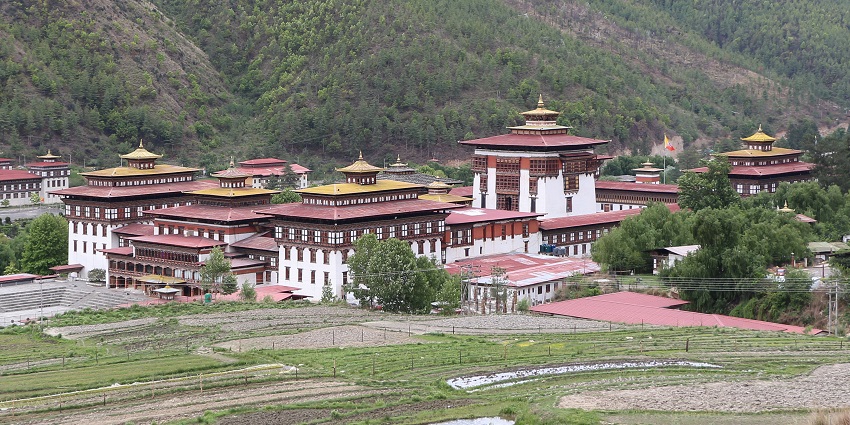
Photo: Bernard Gagnon / Wikimedia Commons
Tashichho Dzong is Thimphu’s religious and administrative capital and, therefore, unique among Bhutan’s landmarks. Tourists have the privilege to see the architecture, stroll across neat lawns, and bask in the serenity of the dzong, particularly at dusk when it is charmingly lit. It is a location where Bhutan’s history, government, and religion all meet, and tourists typically leave with awe at its charm and tranquillity.
Location: Inner Thimphu city
Entry Fee: BTN 300 / ₹300
Best Time To Visit: May–October
Suggested Read: Cheri Monastery Thimphu
4. Tiger’s Nest Monastery

Photo: Gerd Eichmann / Wikimedia Commons
The most renowned Bhutan sight, Tiger’s Nest Monastery, also known as Paro Taktsang, sits on a cliff 3,000 feet above the Paro Valley. The climb up through the pine forest and fluttering prayer flags is strenuous but well worth the effort, with aerial views and a spiritual enchantment spell. Pilgrims are enchanted by the holy atmosphere, chanting monks, and breathtaking surroundings.
Location: Paro Valley, 10 km north of Paro town
Entry Fee: BTN 500 / ₹500
Major Attractions: Cliff monastery, panoramic views, holy caves
5. Chimi Lhakhang In Lobesa Valley
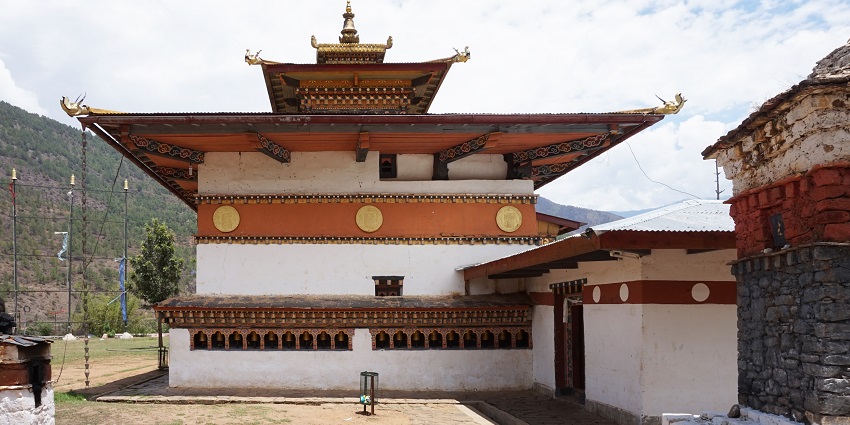
Photo: Bernard Gagnon / Wikimedia Commons
Chimi Lhakhang, the “Temple of Fertility,” is situated on a small hill in the picturesque Lobesa Valley. This quirky Bhutan monument is the shrine of Lama Drukpa Kunley, the “Divine Madman.” It is famous for its playful blessings. Hikers walk through rice fields to the temple, where they can attend fertility ceremonies and walk through peaceful countryside. The lighthearted mood of the temple and beautiful scenery make the holiday one to remember.
Location: Lobesa Valley, Punakha District
Major Attractions: Fertility ceremonies, rural landscape, local legends
Suggested Read: Monasteries In Bhutan Among Its Scenic Vistas
6. Jambay Lhakhang In Bumthang
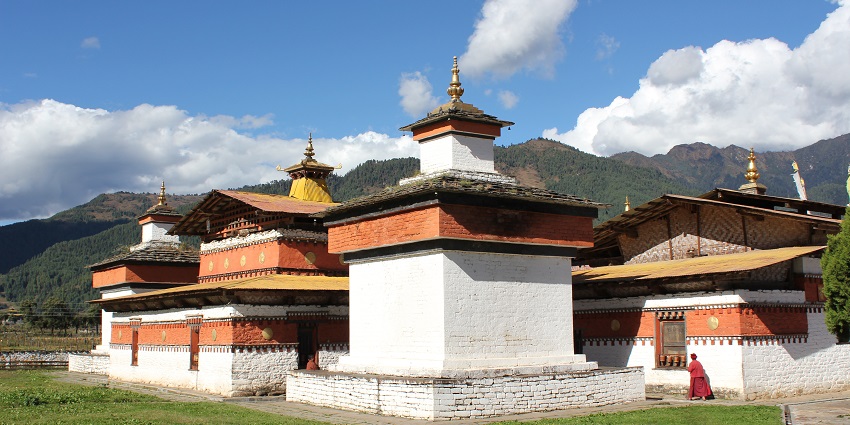
Photo: Around Jakar, Jambay Lhakhang / Wikimedia Commons
Jambay Lhakhang is one of the oldest temples of the Bhutanese monuments, built during the 7th century by King Songtsen Gampo of Tibet. The temple is renowned because of its multi-coloured festivals, and the most prominent is the fire blessing ceremony. People can see the aged halls, divine images, and the colourful Jambay Lhakhang Drup festival. The spiritual atmosphere and festive sentiments make it a must-see place for any tourist in Bumthang.
Location: Bumthang Valley
Major Attractions: Fire festival, ancient artefacts, religious rituals
7. Kurjey Lhakhang At Bumthang
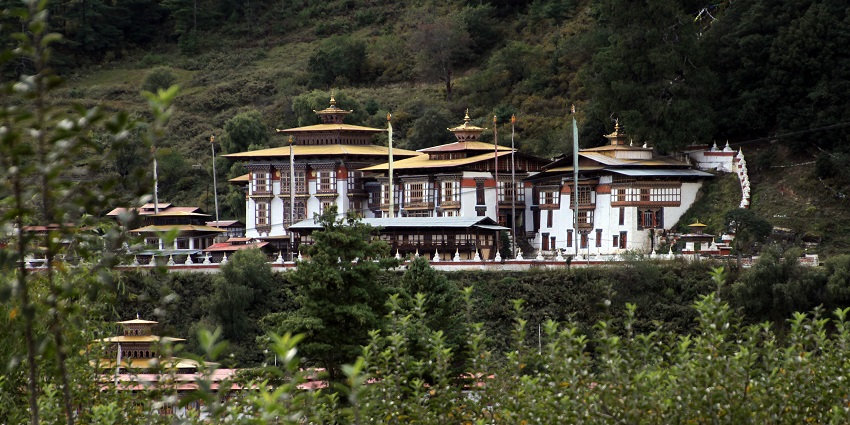
Photo: Gerd Eichmann / Wikimedia Commons
Kurjey Lhakhang, situated in a serene valley, is another of Bhutan’s prominent monuments. The temple complex contains Guru Rinpoche’s body imprinted on a rock and is crowned by tall cypress trees. Travellers can walk through peaceful courtyards, visit three temples, and imbibe the tranquil surroundings. The spiritual charm of the site, blended with nature’s glory, is a pilgrims’ site for seekers who desire to enter the inner realm of Bhutan.
Location: Bumthang Valley
Major Attractions: Footprint of Guru Rinpoche, temple complex, cypress forest
Suggested Read: Bumthang Valley
8. Buddha Dordenma

Photo: Suraphat Nuea-on / Pexels / Image For Representation Only
Buddha Dordenma, a gigantic 177-foot statue, is one of Bhutan’s most beautiful monuments. Standing atop Thimphu Valley, the statue is filled with thousands of miniature Buddha statues and offers views over the city and mountains. One can meditate, take photos, and revel in Bhutanese grandeur. The serene atmosphere and panoramic views ensure this is an unmissable visit to Thimphu.
Location: Kuenselphodrang, Thimphu
Nearest Airport: Paro (55 km)
9. Simtokha Dzong
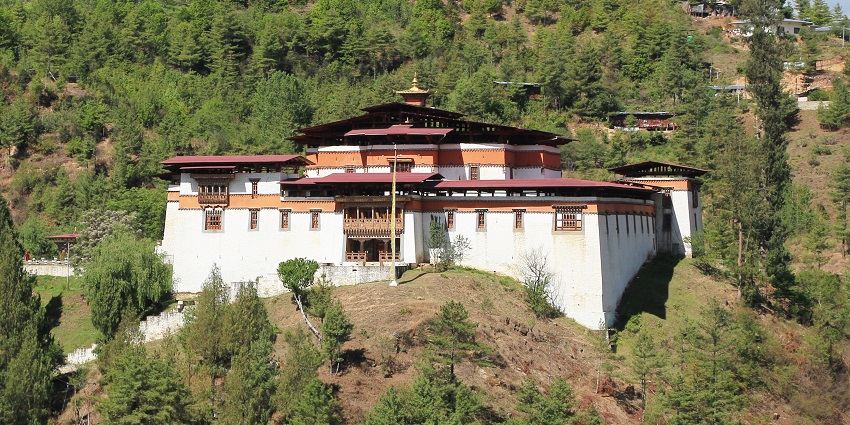
Photo: Bernard Gagnon / Wikimedia Commons
Simtokha Dzong, built in 1629, is the oldest of Bhutan’s fortress monuments. It is now a Buddhist school of studies and is famous for its highly decorated stone and murals from the earliest times of Bhutan’s history. One can walk along old corridors, listen to monks chanting, and relish the dzong as the guardian of Bhutanese tradition, Living tradition is an attractive destination to visit, ideal for contemplation.
Location: 5 km south of Thimphu
Major Attractions: Stone carvings, Buddhist school, historic murals
Suggested Read: Discover The Top Things To Do In Bhutan
10. Trongsa Dzong
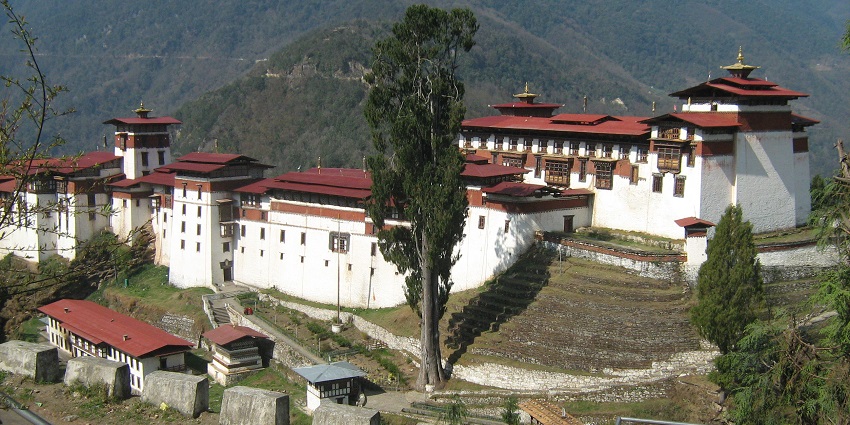
Photo: WindHorse / Wikimedia Commons
Trongsa Dzong, Bhutan’s largest dzong, is perched over the Mangde River in a commanding position. The monument has been of great significance to the nation’s history as the ancestral seat of the Bhutan royal dynasty. Tourists can explore maze-like corridors, see the watchtower museum, and experience incredible valley views. The dzong’s royal heritage and stunning scenery make it a favourite among history buffs.
Location: Trongsa, mid-Bhutan
Best Time To Visit: October–December
Major Attractions: Watchtower museum, valley vistas, royal history
Monuments in Bhutan are more than architectural marvels—they are living testaments to the nation’s spiritual and cultural essence. Dzongs like Punakha, Tashichho, and Trongsa serve as both religious sanctuaries and administrative centres. Temples such as Kyichu Lhakhang and Jambay Lhakhang echo centuries of myth and devotion. Each monument offers a profound glimpse into Bhutan’s soul, where history, nature, and spirituality converge. Book your journey with TripXL today.
Cover Photo: Arian Zwegers / Wikimedia Commons


 WhatsApp
WhatsApp
 Twitter
Twitter









